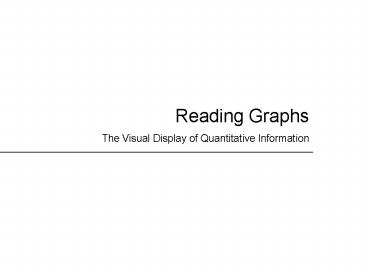Reading Graphs PowerPoint PPT Presentation
1 / 39
Title: Reading Graphs
1
Reading Graphs
The Visual Display of Quantitative Information
2
Challenger Launch
- On launch day it was very cold
- As with previous launches, NASA experts labored
over whether or not to launch - A fatal decision was made, and the shuttle
exploded on take-off
3
Post Hoc Analysis (Tufte)
4
Post Hoc Analysis (Tufte)
Linear regression predicts only limited failure
5
Post Hoc Analysis (Tufte)
Visual inspection leads us to logistic
regression, and a much different outcome
6
Graphing
- The visual display of quantitative information is
a viable means of analysis, and often gives us
insight into relationships. - Overview
- Conventions (not research) guide the creation of
graphs these conventions serve as guidelines
but not rules - We must exercise caution when reading graphs
- Being familiar with the most common types, line,
bar, and scatter, is prudent
7
Conventions
Scores
Age of Children in Mr. Riveras Class
20
20
15
15
DV
frequency
10
10
5
5
9
11
1
2
3
4
8
10
IV
Time
- Longitudinal data plotted with lines
- Time on the x-axis (abscissa)
- Frequency on the y-axis (ordinate)
IV on the x-axis DV on the y-axis
8
Conventions
4
3
Y
2
1
1
2
3
X
- X to Y is 3 to 4 (but does it really matter?)
9
Conventions
75th to 90th percentile
25th to 75th percentile
10th grade science scores
10th to 25th percentile
September
January
Interquartile range with box and whisker (but not
always)
10
Conventions
9
8
7
6
5
The squiggle represents a gap in the data
presented
11
Cautions Reading (and creating)
- Leading title
- Unknown units
- Axis manipulation
- chart junk
12
Leading Title
13
Unknown Units
14
Axis manipulation
15
Chart Junk
16
Misleading Scale
17
Examples
- Can you see the error?
18
Examples
Y-axis manipulation
19
Example
500
475
450
2002
2001
2000
1999
1998
Stock market crash?
20
Example
500
250
0
2002
2001
2000
1999
1998
21
Example
500
250
0
2000
1990
1980
1970
1960
22
Examples
Lie factor 2.8
23
Examples
X-axis manipulation interval deception
24
Examples
Unknown units
25
Examples
Unknown units
26
Examples
Deceptive relationship portrayed with lines
27
Examples
Exaggerated increase (x-scale)
28
Examples
29
Examples
30
Examples
The Politics of Charting Reading Scores
Non-equivalent scales (apples and oranges)
Deceptive x-axis (500)
31
Examples
Lukes Income
Phils Income
So many things, it makes me sick
32
Reading Line Graphs
Scores
20
15
DV
10
5
4
1
2
3
Time
Slope is rate of change (rise/run), but the scale
can create deception
33
Reading Line Graphs
Test Questions
1.0
question 1
question 2
probability of answering the question correctly
0.5
0
-3
-2
-1
0
1
2
-4
3
student ability
The Item Characteristic Curve (ICC) describes
test questions
34
Reading Line Graphs
Student Test Results
200
school A
number of students
100
school B
0
-3
-2
-1
0
1
2
-4
score
High vs. normal performing
35
Stem and Leaf or Line?
5
2
5
6
1
7
7
8
0
2
Developed by Tukey in the mid 1970s Mirrors a
histogram sets of bins
36
Reading Scatter Plots
8
7
number of errors
6
5
4
3
5
6
7
8
9
age
In the graph, each dot shows the number of errors
and corresponding age for each of 13 people.
According to the graph, what is the approximate
median number of errors for the 13 people?
3
4
5
6
In a scatter plot, the median is really just the
middle Each dot has two values in the Cartesian
plane
37
Reading Scatter Plots
217
216
state reading score
215
214
213
212
60
70
80
90
100
reading fluency
30. In the graph, each dot shows both the large
scale state reading score and the reading fluency
score of each of 11 people. Dotted lines are cut
scores and indicate proficiency on each measure.
How many students met the fluency cut score but
failed to meet the state reading cut score?
none
1
2
3
38
Reading Pie Graphs
37o
Use only to represent parts of a whole Place the
referent line on the horizontal
39
Display for Making Decisions
- Visual displays help us see relationships in data
- Data should be held in context (referent)
- Data should provide quantitative comparisons
(multidimensionality) - Consider and address alternative explanations
(display as a decision making tool) - Use conventions are guidelines
- Beware misleading graphs

